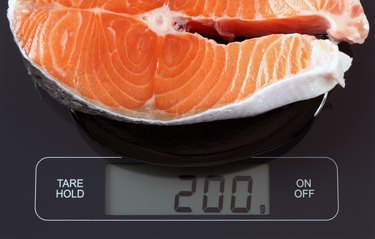
Regardless of whether you want to lose, gain or maintain weight, a food scale is a handy kitchen tool that can help you better identify portion sizes.
Increasing portion sizes have contributed directly to American obesity, the Centers for Disease Control and Prevention (CDC) reports. In its review of research about portion size, the CDC found that most Americans don't understand the difference between portion size and serving size.
Video of the Day
Video of the Day
Learning how to use a food scale will help you recognize the correct serving size for the foods you eat, helping you to naturally cut back on calories and lose weight.
Step 1: Choose the Right Scale
Determine what type of food scale you want to use. Some people prefer to purchase a digital scale because it offers exact measurements without guesswork; other options include spring and weight scales.
When choosing, focus on selecting a scale that has numbers you can easily read, is within your budget, has a bowl or cup for holding food and is easy to maintain.
Step 2: Read the Manual
Read the manual that comes with your scale. A simple scale might not come with a manual but some digital scales have advanced features like calorie measurements and nutritional values. Reading the instructions will help you understand your scale's particular features.
Step 3: Clear the Scale
Before weighing anything, make sure you zero out your scale. Depending on the type of food scale you've purchased, this could be as simple as turning the scale on and waiting until the display registers 0. For spring and weight scales, you might need to turn a knob on the scale to 0.
Step 4: Weigh the Container
Weigh the bowl or container you will use to store the food you're weighing. You need to know the weight of the container in order to subtract it from the number the scale registers when you add food to it. The answer will give you the actual weight of your food.
Some scales that come with a container have a special button that automatically accounts for the container; follow manufacturer's instructions to use this feature.
Step 5: Weigh Your Food
Place your food portion in the container on the scale. If you are using a weight or spring scale, give the scale a few moments to settle before reading the weight.
If you're using a digital scale, you'll either see the weight displayed automatically or you may have to enter a special code that indicates the type of food you're weighing into the scale. Follow manufacturer's directions to obtain the correct reading.
Wondering how to calculate your calories for weight loss? Download the MyPlate app to do the job and help you track your intake, so you can stay focused and achieve your goals!
Step 6: Calculate the Actual Weight
Subtract the weight of the container, if necessary, from the reading to calculate your final weight measurement.
Tip
Experts offer different opinions on when you should weigh your food. One rule of thumb is that you weigh meat after cooking, but grains, fresh fruits, vegetables and other items that expand after cooking should be weighed before cooking.
Another option is to weigh food both before and after cooking, which allows you to see what a serving portion looks like in both states.
Was this article helpful?
150 Characters Max
0/150
Thank you for sharing!
Thank you for your feedback!